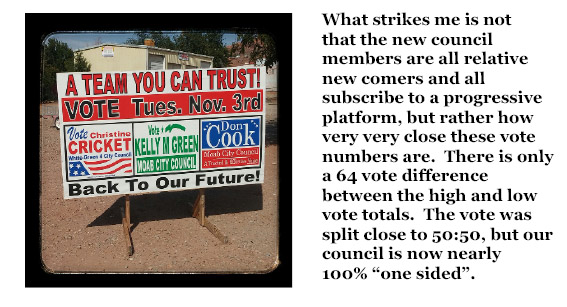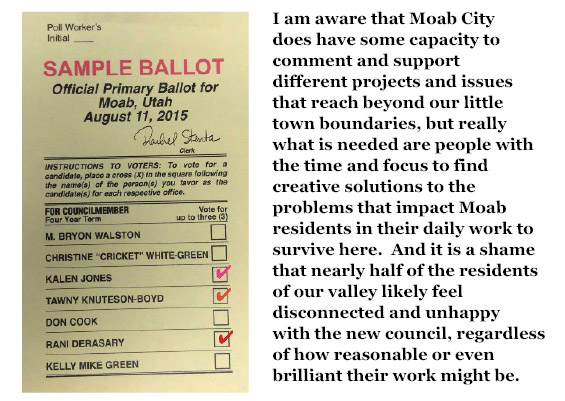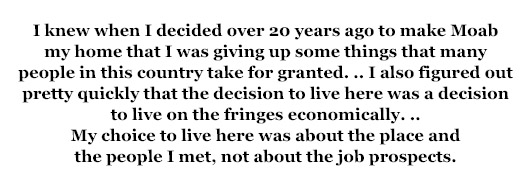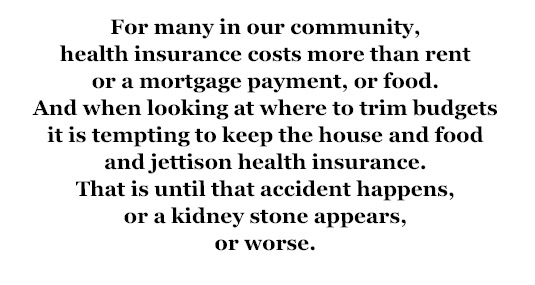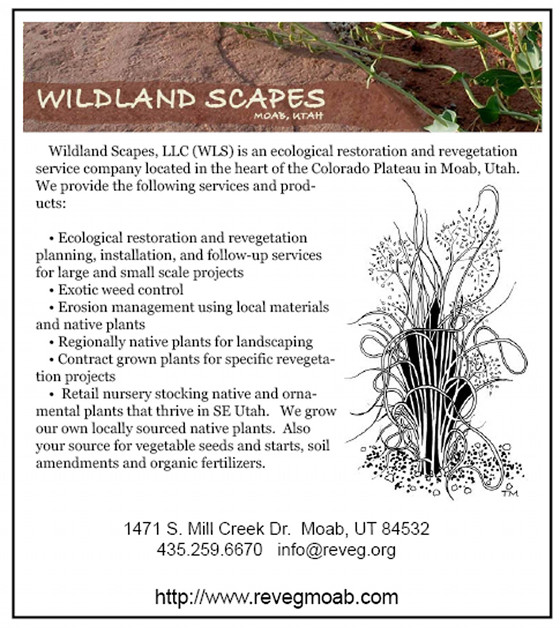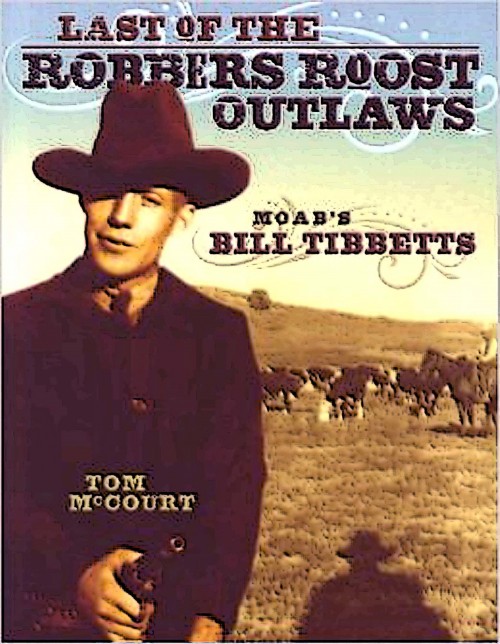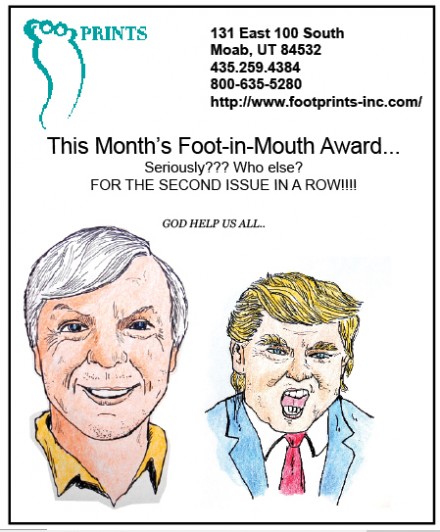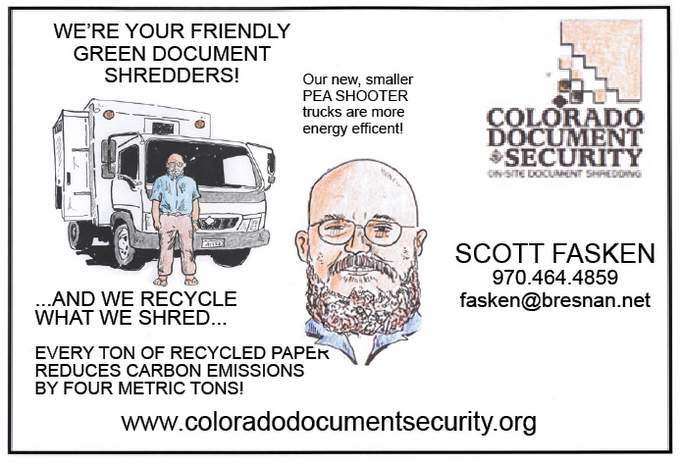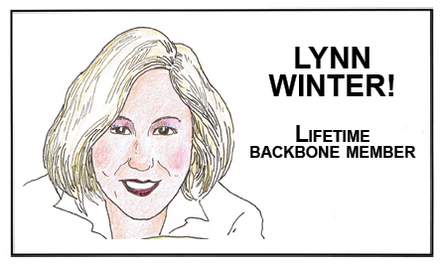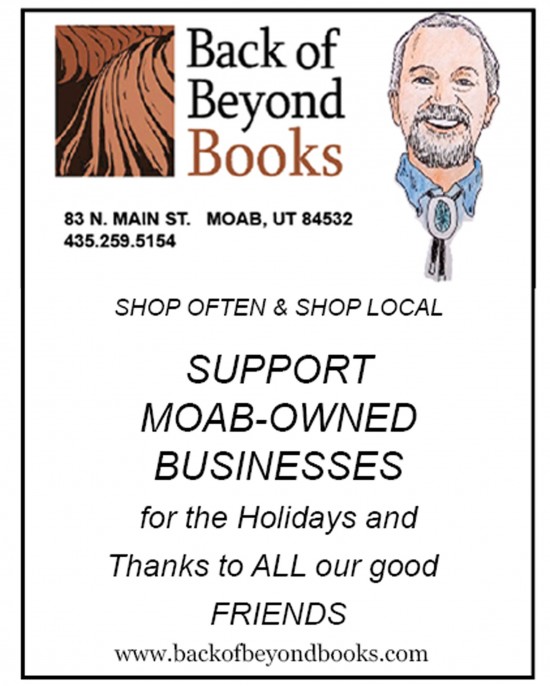ELECTIONS – ALL OR NONE
November started with a bang here in Moab. With four major events in town the weekend of November 7th, there was not a hotel room to be found in town. It is plain that the old pattern of an “off season” starting around October 31 is no longer part of Moab’s year. 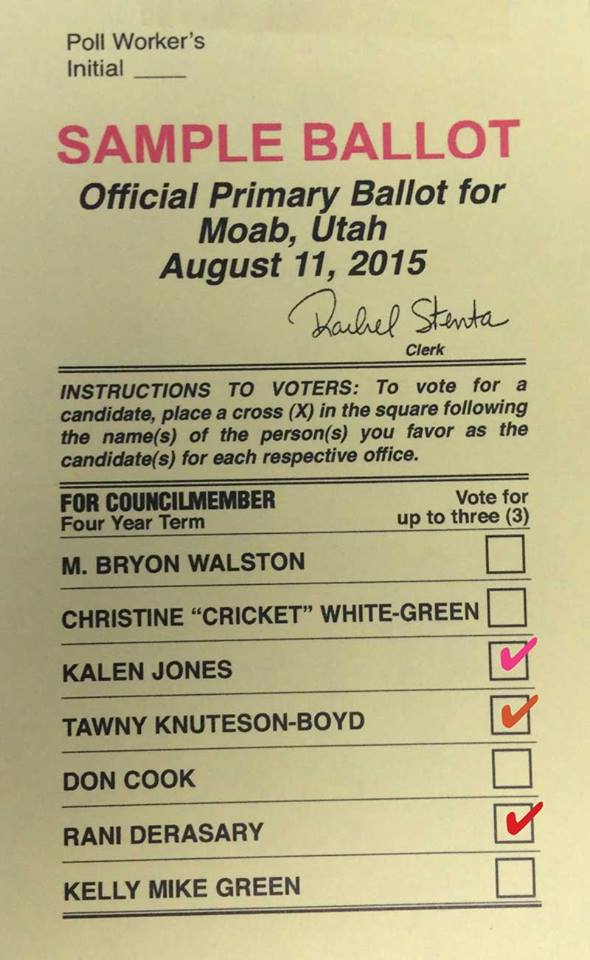
Nearly 61% of eligible voters in Moab City voted in an election on November 2nd that was purely local. There was enough early voting that the City had to order additional ballots for election day to be sure to have enough on hand. I’d love to see even higher turn out, but compared to national averages over the years hovering around 35% or lower, it is pretty clear that Moab’s population votes. The incessant phone calls the week prior to the election helped assure that Moabites didn’t forget to go vote.
The interesting result to me is less who won, but rather how close the margins are between the new council members and those whose bids for seats were unsuccessful. The final count showed the difference between the high vote win of 737 (or 52% of the votes cast) and the low vote total of 673 (or 47% of votes cast) is only 4%. The other two winning seats won by only 1 and 2% of the vote. This was a very tight race.
Rani Derasary 737
Don Cook 674
Kalen Jones 707
Christine “Cricket” White Green 673
Tawny Knudson Boyd 690
Kelly Mike Green 673
TOTAL NUMBER OF BALLOTS CAST: 1429
What strikes me is not that the new council members are all relative new comers and all subscribe to a progressive platform, but rather how very very close these vote numbers are. There is only a 64 vote difference between the high and low vote totals. The middle two candidates, as of the final vote count, were only 16 votes apart – a clear indication that voting matters. The vote was split close to 50:50, but our council is now nearly 100% “one sided”.
When I saw the early result numbers late the night of November 2nd my mind immediately flashed to the huge ad in the center of the paper the week prior showing Cricket White Green, Kelly Green and Don Cook, encouraging voters to vote for the three of them together as a package. Progressive mailers in my post office box (that went straight into the handy recycling bins in the lobby since I had already voted by the time I received them) presented a similar package deal with Rani Derasary, Tawny Knutson Boyd and Kalen Jones. This is a repeat of last year’s election materials for County positions.
And Moab City Council seats are supposed to be non partisan.
It seems to me that the issues facing Moab City need skills and attention to detail that are not necessarily illustrated by the left or right leaning of a political candidate. The issues really facing Moab today include: a sewer system in need of significant upgrading; a lack of housing for most wage classes of workers in Moab; and whether we really have enough water; what to do if USGS reports show we don’t have enough water to support build out to over 10,000; not to mention the traffic problems including the impossibility of turning left off Main Street. There are certainly philosophical differences in how candidates might approach these topics that can be illustrated by political affiliation. But it seems to me that the skill set needed to examine, analyze and decide what might be done to alleviate, or if possible solve, some of these problems has more to do with a willingness and ability to learn about the issues and possible actions, the time to really spend working with other people, and a clear understanding of how we got here – both physically and socially.
I am aware that Moab City does have some capacity to comment and support different projects and issues that reach beyond our little town boundaries, but really what is needed are people with the time and focus to find creative solutions to the problems that impact Moab residents in their daily work to survive here. And it is a shame that nearly half of the residents of our valley likely feel disconnected and unhappy with the new council, regardless of how reasonable or even brilliant their work might be. It may mean that those same residents, who may have some great input into how to address our collective problems, will have an adversarial rather than collaborative view of Moab City. Couple that with recent staff changes that mystify most residents and add a layer of sinister unknown to impressions of the City, and I worry that important players will not participate at all until the next election. It seems we are in a constant battle of whose ideology wins the majority vote as opposed to who will work the hardest and smartest for the residents of Moab.
I have lived in this valley long enough to watch the political pendulum swing from extreme right to extreme left and back again, with a fairly constant stream of arguing, name calling and sometimes downright dirty politics along the way. If we voted based on skills, available time, dedication, and communication performance perhaps we could break this cycle swinging left and right so extremely and be able to focus on getting something done that works for the town as a whole.
I understand that advertising and campaigning is up to the candidates and to the groups that support them. And many people vote along a straight party line; and the majority wins, not a 2/3 majority but just one vote over is enough. But what it is doing in a small place like Moab is highlighting divisiveness rather than building our community. It is a small town and I can’t help but remember once meeting Cricket at the title company, or seeing Kelly at a planning commission meeting, or when Don worked in the corner office at First Security bank. I have known Rani for years, and have worked with Kalen off and on over the years, and I know Tawny by sight. But finding out what these candidates really thought and how they might address the problems facing Moab today was not easy.
Both papers published information submitted by each candidate, but few of these essays provided tangible ideas of what could and perhaps should be done. Campaigns are by nature focused on sound bites and abbreviated versions of what candidates think, they have to be since most of us have pretty short attention spans for these topics. But they rarely give a clear idea of how a candidate might actually address real problems and issues that face the community.
Nuances of the community perspective and history of place, some of which are be rather important, are lost when votes are so closely divided but resulting in a governing body that is relatively homogenous in terms of political affiliation. I can’t help but wonder if we all really talked to each other about how to solve the problems in front of us if there might be more in common than we think there is when we identify each person with their political leaning.
If we are going to have nonpartisan positions, as voters we should take responsibility to learn about the individual candidate’s record and knowledge about the issues facing Moab. It may not change the way we vote, but it might mean we don’t vote for the two or three that appear to have similar progressive or conservative leanings to our own, but we might mix it up a bit. I didn’t vote for a package, but it took some time to figure out who I thought would spend the time, have the patience and communication skills, and be able to wade through it all to represent us well.
I suppose I am naïve, but in my perfect world the resulting council would have voices from all sides of the community who communicate and work together to find solutions to the challenges facing our little town. It would likely be downright messy, but it would better reflect who we are, and we might come up with some better solutions.
INSURANCE ON THE FRINGES
November also began with news released a week prior that for Grand County residents there is now only one health insurance company participating in the insurance exchange with local doctors and services “in network”. This followed re-enrollment letters that knocked me over with the rate increases. Then came a period of time where insurance looked impossible without returning to higher cost plans from national companies that do not participate on the insurance exchange, meaning that assistance to pay for insurance would no longer be an option.
 I knew when I decided over 20 years ago to make Moab my home that I was giving up some things that many people in this country take for granted. I quite liked that the nearest major shopping is 120 miles (or arguably 250 miles) away. I also figured out pretty quickly that the decision to live here was a decision to live on the fringes economically unless I took on a government job or joined the ranks at City Market. That left health insurance options pretty slim, though when I first moved here in my early twenties that didn’t much matter. My choice to live here was about the place and the people I met, not about the job prospects.
I knew when I decided over 20 years ago to make Moab my home that I was giving up some things that many people in this country take for granted. I quite liked that the nearest major shopping is 120 miles (or arguably 250 miles) away. I also figured out pretty quickly that the decision to live here was a decision to live on the fringes economically unless I took on a government job or joined the ranks at City Market. That left health insurance options pretty slim, though when I first moved here in my early twenties that didn’t much matter. My choice to live here was about the place and the people I met, not about the job prospects.
The health care system is quite obviously controlled by corporations run from large cities where the reality of living 120 to 200 miles from the nearest metropolitan center large enough to support health care choices is unfathomable. The systems in place do not accommodate the needs of far flung communities– especially when they happen to be located where the closest health care providers are in an adjacent state.
I have had numerous conversations with people in Moab about health insurance lately. I have heard more about people’s personal health situations than I ever have before – and it all starts with commiserating about insurance. A few years ago, just before the Affordable Care Act (ACA) was passed, our family was faced with some significant health care expenses for the first time. Before the ACA I found the system overwhelming, confusing and somewhat frightening. How to pick a specialist when the first consideration must be whether the specialist is in or out of network, rather than based on who has the best recommendations or experience with our specific problem, or is located within a tolerable drive time so that appointments are not a two day affair.
I realize that I have been lucky so far in life to have few health concerns, but that can change at any time. Knowing that everything I have worked to build up over the last 20 years could be taken away by medical bills I can’t afford is terrifying. Recently I had a conversation with a friend who had his first medical experience in Moab and found himself questioning whether to go into the ER because he just wasn’t sure what it would cost suggests to me these problems are still there.
It is not just people under 30, or deadbeats with no job, or people who choose seasonal work and move 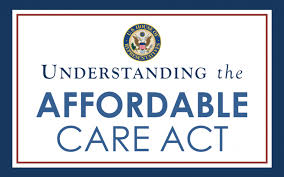 around a lot who are impacted by this rollercoaster ride of health insurance. It is longtime residents – micro business owners and their employees – who are most battered about in this situation. Micro businesses can’t afford group rates to cover their staff, I did it for years and it is prohibitively expensive. It has always bothered me that in this country to ensure access to health insurance you can afford you have to take a job with benefits, which usually means at a large corporation or with a government entity. This leaves most small businesses who may offer good satisfying work at a decent wage, at an extreme disadvantage. This policy (unwritten as it is) also means that people stay in jobs far longer than they want to, or in some cases should, simply out of fear of losing these benefits.
around a lot who are impacted by this rollercoaster ride of health insurance. It is longtime residents – micro business owners and their employees – who are most battered about in this situation. Micro businesses can’t afford group rates to cover their staff, I did it for years and it is prohibitively expensive. It has always bothered me that in this country to ensure access to health insurance you can afford you have to take a job with benefits, which usually means at a large corporation or with a government entity. This leaves most small businesses who may offer good satisfying work at a decent wage, at an extreme disadvantage. This policy (unwritten as it is) also means that people stay in jobs far longer than they want to, or in some cases should, simply out of fear of losing these benefits.
Some small businesses can afford to offer health insurance. For many micro businesses, defined in the New York Times as those with around 10 employees and less than $1,000,000 in annual sales, it is nearly impossible to afford to offer insurance. It is hard to find data on small and micro businesses in the US, but as of 2011 (the newest data I could find) there were 28,175,504 businesses in the US. Of these, 27,002,131, or 95.8% of them, have 10 or fewer employees. That means that nearly 96% of the businesses in the US are micro businesses. Only 17,671, or 0.06%, businesses in the US have 500 or more employees. The remaining businesses fall somewhere between 10 and 500 employees. It is micro businesses who employ the bulk of the population of the US and are at an extreme disadvantage in attracting and retaining employees simply because they cannot offer health insurance as a benefit to their employees – and they have a hard time insuring themselves as well.
For many in our community, health insurance costs more than rent or a mortgage payment, or food. And when looking at where to trim budgets it is tempting to keep the house and food and jettison health insurance. That is until that accident happens, or a kidney stone appears, or worse.
These problems existed before the ACA was enacted. And subsequent years of fighting over whether insurance can be only available to those with year round full time jobs, very high incomes, or personal wealth rather than working together to revise ACA programs so that these programs to help everyone afford insurance can function has left us with a system that is beyond broken. Looks like I, and hundreds of other SE Utah residents, will be signing up with SelectHealth, the only game in town if you need assistance paying for your health insurance.
Kara Dohrenwend is a regular contributor to the Zephyr. She lives in Moab, Utah.
To read the PDF version of this article, click here.
To comment, scroll to the bottom of the page.
Don’t forget the Zephyr ads! All links are hot!


